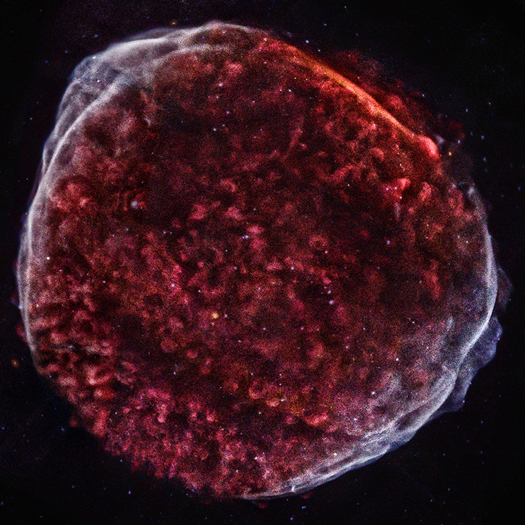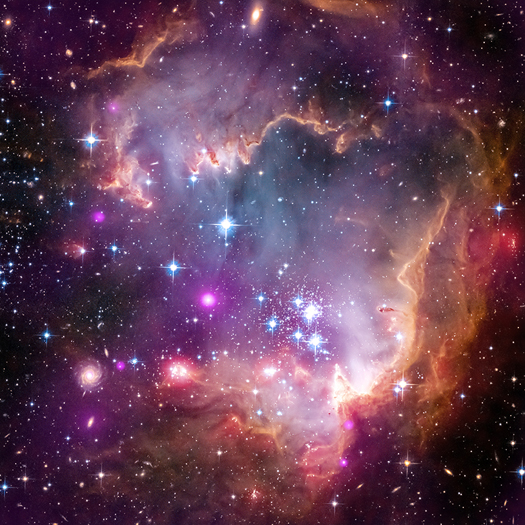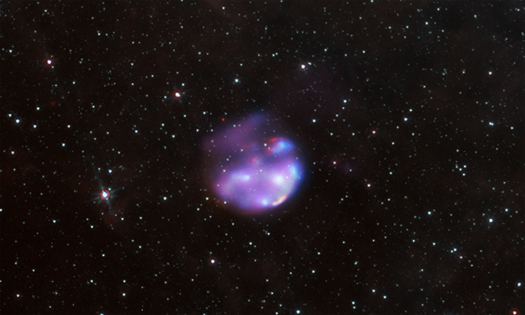X-Ray View of A Thousand-Year-Old Cosmic Tapestry
This year, astronomers around the world have been celebrating the 50th anniversary of X-ray astronomy. Few objects better illustrate the progress of the field in the past half-century than the supernova remnant known as SN 1006.
Taken Under the "Wing" of the Small Magellanic Cloud
The Small Magellanic Cloud (SMC) is one of the Milky Way's closest galactic neighbors. Even though it is a small, or so-called dwarf galaxy, the SMC is so bright that it is visible to the unaided eye from the Southern Hemisphere and near the equator. Many navigators, including Ferdinand Magellan who lends his name to the SMC, used it to help find their way across the oceans.
Wonder and Sublime in Space Imagery
An interdisciplinary and international group from Chandra, the Smithsonian Astrophysical Observatory, and experts in the field of aesthetics from the University of Otago, New Zealand, formed the Aesthetics and Astronomy group - known as the A&A project -- back in 2008 to explore how astronomy images are perceived.
Amanda Berry, an MFA graduate student at Kendall College of Art and Design in Michigan, is researching "space" as a visual knowledge field. She asked some great questions to the Aesthetics & Astronomy project, which Jeffrey Smith kindly answered. We thought you might enjoy the read:
The Remarkable Properties of Neutron Stars
Note: An earlier version of this article appeared on this blog by Peter Edmonds.
The collapse of a massive star in a supernova explosion is an epic event. In less than a second a neutron star (or in some cases a black hole) is formed and the implosion is reversed, releasing prodigious amounts of light that can outshine billions of Suns. That is a spectacular way to be born. Here, I'll explain that the properties of neutron stars are no less spectacular, even though they are not as famous as their collapsed cousins, black holes.
Because of the incredible pressures involved in core collapse, the density of neutron stars is astounding: all of humanity could be squashed down to a sugar cube-sized piece of neutron star. The escape velocity from their surface is over half the speed of light but an approaching rocket ship would be stretched, then crushed and assimilated into the surface of the star in a moment. Resistance would be futile.
Meet an Astronomer: Paul Green (Part 2)
Paul Green is an astrophysicist at the Harvard-Smithsonian Center for Astrophysics. His scientific research includes the study of quasars and carbon stars. He pursues these topics while working in Chandra's Director's Office, helping to ensure that the science of the telescope gets done smoothly. When he's not doing all of these things, Paul is also known to play a mean bass guitar.
Famous Supernova Reveals Clues About Crucial Cosmic Distance Markers
This is the remnant of Kepler's supernova, the famous explosion that was discovered by Johannes Kepler in 1604. The red, green and blue colors show low, intermediate and high energy X-rays observed with NASA's Chandra X-ray Observatory, and the star field is from the Digitized Sky Survey.
As reported in our press release, a new study has used Chandra to identify what triggered this explosion. It had already been shown that the type of explosion was a so-called Type Ia supernova, the thermonuclear explosion of a white dwarf star. These supernovas are important cosmic distance markers for tracking the accelerated expansion of the Universe.
Taking Another Look at a Historical Supernova
We are delighted to welcome Mary Burkey as a guest blogger today. Mary is first author of a paper, describing the trigger mechanism for the Kepler supernova, that is the subject of our latest press release. She grew up in Raleigh, North Carolina and is in her last semester at North Carolina State University. When she graduates in May, she will have Bachelors degrees in Physics, Chemistry, and Applied Mathematics. After commencement, Mary will attend one of the graduate schools she is currently exploring and plans to obtain a PhD in Physics.
When people all over the world looked up into the night sky 409 years ago and saw a new star, they immediately began studying it. However, no one studied this new celestial object more closely than Johannes Kepler. Over several years, he synthesized his observations into a historical book, De Stella Nova, which later justified naming the star “Kepler’s supernova.”
NASA's Swift, Chandra Explore a Youthful 'Star Wreck'
While performing an extensive X-ray survey of our galaxy's central regions, NASA's Swift satellite has uncovered the previously unknown remains of a shattered star. Designated G306.3-0.9 after the coordinates of its sky position, the new object ranks among the youngest-known supernova remnants in our Milky Way galaxy.
Probing Extreme Matter Through Observations of Neutron Stars
Neutron stars, the ultra-dense cores left behind after massive stars collapse, contain the densest matter known in the Universe outside of a black hole . New results from Chandra and other X-ray telescopes have provided one of the most reliable determinations yet of the relation between the radius of a neutron star and its mass. These results constrain how nuclear matter - protons and neutrons, and their constituent quarks, interact under the extreme conditions found in neutron stars.
Meet an Astronomer: Paul Green (Part I)
Paul Green is an astrophysicist at the Harvard-Smithsonian Center for Astrophysics. His scientific research includes the study of quasars and carbon stars. He pursues these topics while working in Chandra's Director's Office, helping to ensure that the science of the telescope gets done smoothly. When he's not doing all of these things, Paul is also known to play a mean bass guitar.





